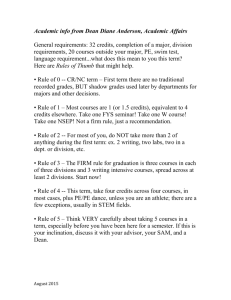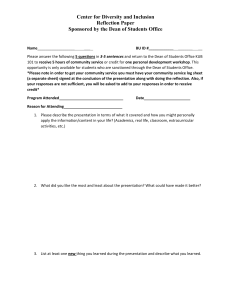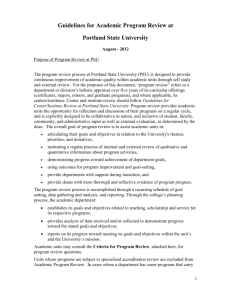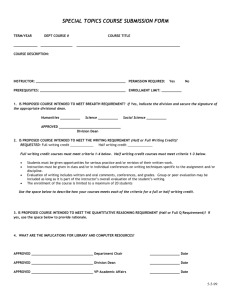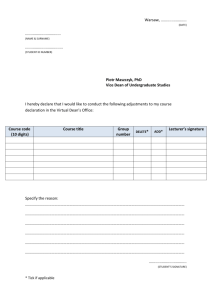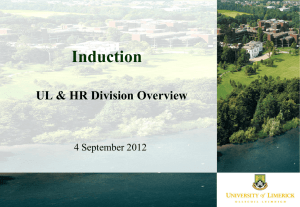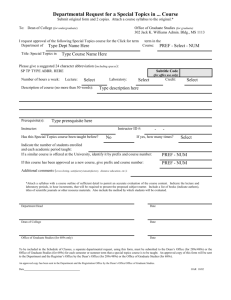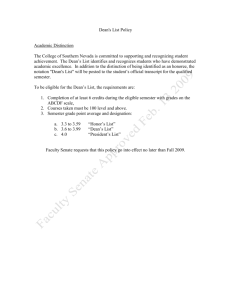AcademicProgram Review - Portland State University
advertisement
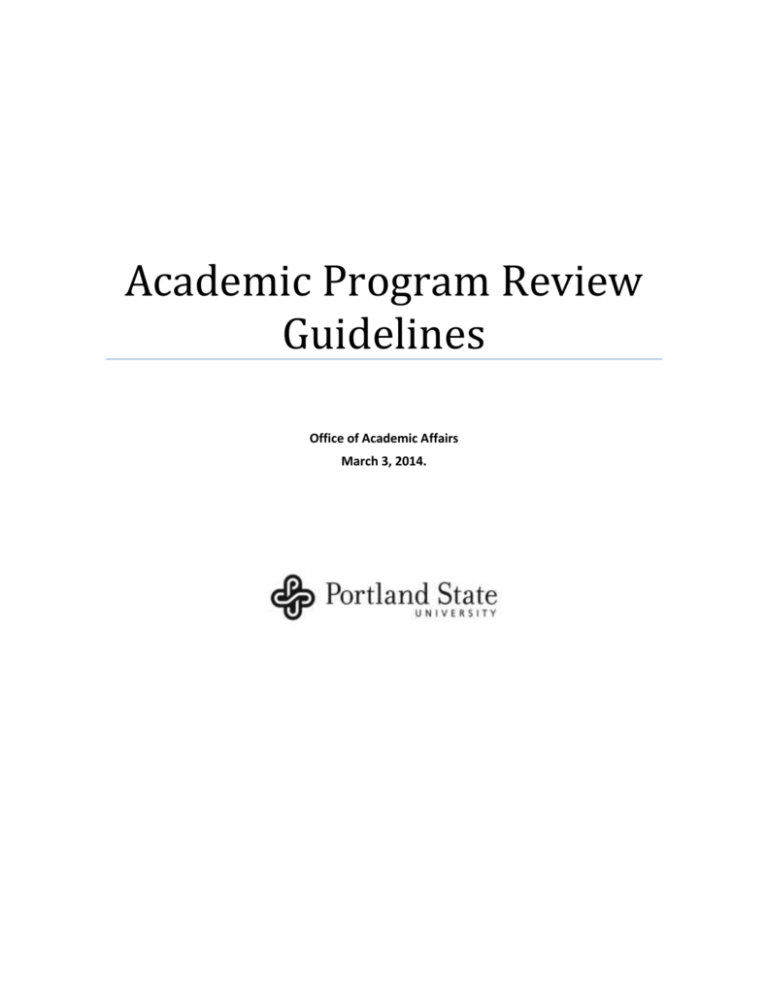
Academic Program Review Guidelines Office of Academic Affairs March 3, 2014. Purpose of Program Review at PSU The program review process at Portland State University (PSU) is designed to provide continuous improvement of academic quality within academic units through self study and external review. For the purposes of this document, “program review” refers to a department or division’s holistic appraisal over five years of its curricular offerings (certificates, majors, minors, and graduate programs), and where applicable, its centers/institutes. Center and institute review should follow Guidelines for Center/Institute Review at Portland State University. Program review provides academic units the opportunity for reflection and discussion of their programs on a regular cycle, and is explicitly designed to be collaborative in nature, and inclusive of student, faculty, community, and administrative input as well as external evaluation, as determined by the dean. The overall goal of program review is to assist academic units in: articulating their goals and objectives in relation to the University's themes, priorities, and initiatives, instituting a regular process of internal and external review of qualitative and quantitative information about program activities, demonstrating progress toward achievement of department goals, using outcomes for program improvement and goal-setting, provide departments with support during transition, and provide deans with more thorough and reflective evidence of program progress. The program review process is accomplished through a recurring schedule of goal setting, data gathering and analysis, and reporting. Through the college’s planning process, the academic department: establishes its goals and objectives related to teaching, scholarship and service for its respective programs; provides analysis of data received and/or collected to demonstrate progress toward the stated goals and objectives; reports on its progress toward meeting its goals and objectives within the unit’s and the University’s mission. Academic units may consult the Criteria for Program Review, attached here, for program review questions. Units whose programs are subject to specialized accreditation review are excluded from Academic Program Review. In cases where a department has some programs that carry specialized accreditations and others that do not, faculty should consult their deans to determine a reasonable process of review that does not duplicate efforts. 1 Review Schedule An annual timeline for program review, and a master schedule of departmental rotation will be published on the OAA website. Deans, in collaboration with OAA, are responsible for setting review schedules for their units on a 5-7 year cycle (unless otherwise dictated by the specialized accreditation agency). Those units with specialized accreditation may complete their accreditation body’s program review process and submit it to OAA in lieu of the PSU process and format described here. Submission to OAA is required in either case. Procedures Program review procedures are outlined below. In consultation with the Provost and Vice Provost for Academic Programs and Instruction, deans and department chairs may modify these procedures to accommodate particular circumstances. Preparation At the beginning of each academic year, the Office of Academic Affairs (OAA) sends a reminder to the Office of Institutional Research and Planning (OIRP) and to the dean listing the programs or departments he or she has indicated will be subject to review during the academic year. OIRP will provide the department/program being reviewed with the requisite data indicated in the Criteria for Program Review below. Reviews will begin in Fall term and must be concluded by the end of Spring term. The dean meets with the programs or departments to develop a process for the reviews and to finalize any decisions about information that will be required beyond what is typically provided by OIRP. The program or department prepares review materials according to the Program Review Criteria, and any additional materials as required by the dean. Core data elements will be pre-populated by the Office of Institutional Research and Planning. (Those departments subject to specialized accreditation should also use these data, but may prepare other materials as required by their accrediting agencies.) Review Process and Timeline The following represents a standard chronology of steps and recommended deadlines for each step in the process. If submission of a completed APR to OAA is not possible by the final June 1st deadline, a request detailing the reasoning must be made by the appropriate Dean. Spring Term OAA alerts deans of the pending reviews scheduled for the next academic year, Fall term. Review process begins, The responsible dean meets with the units scheduled for review to develop the process for the reviews and to finalize any decisions affecting the information that will be required beyond what is provided by OIRP, 2 Department/program begins drafting its self-study, Winter term Department/program completes self-study using the established standards/criteria listed below, March 15th Self-study and list of potential external reviewers submitted to the dean for review and comment, April 1st Reviewers approved and confirmed Spring April 23rd Self-study and dean’s response submitted to external reviewers, May 7th External reviewers brought to campus to conduct review (other arrangements may be made at the discretion of the dean, i.e., virtual reviews are possible), May 15th External reviewers prepare a report and submit it to the dean, May 23rd The dean prepares a final report for the department/program based on the self-study and the external reviewers’ report, May 23rd The department/program prepares a response to the reports of the external reviewers and the dean, Departments/programs with institutes and centers will simultaneously initiate a review of those centers and institutes following the “Guidelines for Center/Institute Review at Portland State University”, June 1st. The complete review packet (self-study, dean’s response, external review report, dean’s report and department/program response) submitted to the Office of Academic Affairs, June 1st The complete centers/institutes review packet submitted to the Associate Vice President for Research and Strategic Partnerships who provides a final report to the Provost, June 15th The Provost reviews and signs off on the department/program report and the centers/institutes report or recommends additional steps in consultation with the dean and VPAPI and/or VPRSP. The cycle begins again with the new academic year. Use of External Reviewers Academic programs undergoing program review are expected to include 2-3 external reviewers in the process. Departments identified for review need to submit names of potential reviewers to their deans, who may add additional names to the list. Two to three external reviewers should receive and review the self assessment written by the department, as well as the dean’s response to the report in advance of their visit to campus. Deans may determine whether one or more reviewers make a site visit, and whether meetings via skype or other means are adequate for review purposes. Deans are expected to cover expenses related to these site visits. 3 Committee Considerations As part of the department/program review, the department/program review committee should consider consultation with, as appropriate, the following: Students (program majors), staff, associated faculty, community partners, disciplinary librarian(s), as well as representatives from OIT, Facilities, Center for Online Learning, and Student Support Services. Guidelines for Academic Program Review The following reports will be available in the Program Review folder contained within the PSU Fact Book folder in Data Master at www.datamaster.pdx.edu . Declared Majors SCH generation Degrees Granted Faculty Load Student Mix Classes with high DFW rates The Office of Institutional Research and Planning (OIRP) will provide a report of faculty characteristics. The Office of Research and Strategic Partnerships (RSP) will provide yearly research expenditures. The Campus Planning Office (CPO) will provide a current assessment of departmental space and a breakdown by usage. The PSU Revenue and Cost Attribution Tool (RCAT) (FY 2013 onwards) can be accessed by each dean’s office to provide an aggregate and a departmental breakdown of the revenue generation that is attributed to the department, the department’s direct costs (yearly Education and General Fund budget) and the department’s attributed indirect costs. 4 Criteria for Program Review Common Criteria 1. Centrality to the PSU mission How does your program/department advance the University’s mission, themes, and priorities? Clearly articulate the goals and objectives of your program/department. Efficiently identify strengths and weaknesses of your program/department. Provide a narrative statement that addresses program/departmental goals and objectives in relation to the overall university mission, themes, and priorities and reflected in the mission/values within the college/departments. This statement can address the cumulative findings of any preceding plans, and should be created by the program/department and reviewed and approved by the dean’s office. Where do you find opportunities to further enhance the unit’s connection to the University’s mission, themes, and priorities, and how do you intend to fulfill those opportunities? 2. Quality of Instruction and Curriculum Does the program have adequate and experienced personnel? Are there areas where your faculty is particularly strong? How does your particular faculty mix support the program’s objectives? Describe the strengths of the curriculum and its quality and rigor. What are the emerging trends in your field? How is your unit poised to address those trends? What is the role and function of online learning in your programs? How does your program support the institutional diversity and international initiatives? Common data elements (required): Faculty Load (Datamaster Report) Faculty Characteristics (contact OIRP) Faculty Service Potential data elements: Number of faculty by tenure status. Number/proportion of diverse faculty. 5 Faculty by full-time/part-time status. Number of faculty with terminal degrees. Number and percentage of tenure-related faculty. Number and type of graduate assistants. Number and FTE of staff. Degree programs offered. Online programs offered. Number of Community Based Learning, Sustainability, Capstone, or other community-based courses offered. Number of diversity-related courses offered. Number of online courses offered. 3. Quality of Scholarly and Creative Work What are your department/program’s current areas of strength? Where is there growth potential? How does the department/program’s scholarly activity advance the curriculum? What are your department/program’s formative and summative assessment measures? To what degree are undergraduate and graduate students involved in scholarly work? How does your particular faculty mix support the program’s research and partnership objectives? Describe the strengths of the scholarly work and its quality and rigor. What are the emerging scholarly trends in your field? How is your unit poised to address those trends? How does the department/program connect through community engagement and service? Common data elements (required): Yearly research expenditures (contact RSP) Potential data elements: Number of proposals and awards for sponsored research grants and contracts. Proportion of faculty involved in research (whether funded or not). Publications, presentations. Citations of published works. Faculty Development Fund awards, number and award amounts. External faculty honors and awards. 4. Program Efficiency and Effectiveness 6 What is your department’s approach to undergraduate advising? Does your department advise students on all requirements for graduation, including general education requirements? What are the barriers to student success in your department (for example bottleneck courses or courses with significant D, W, F rates), and what is the department/program doing to alleviate those barriers? How do you evaluate the effectiveness of your advising plan? Common data elements (required): Degrees Granted (Datamaster Report). Classes with high DFW rates Potential data elements: Advising plans. Degree maps. Enrollment by major. Number of undergraduate degrees awarded (include minors and certificates). Number of graduate degrees awarded (include graduate certificates). Number/proportion of diverse students. Number of doctoral students. Support available to graduate students. Gainful employment information (certificates). 5. Assessment of Student Achievement What is the evidence of the student learning experience? Programs should be able to define and evaluate how well their students are learning through clearly defined learning outcomes and objectives: more specifically, programs should be able to describe the kinds of experiences that they expect students to have inside and outside the classroom. Relevant evidence may pertain to targets for the kinds of reading and writing assignments that students should complete; levels of personal interaction with faculty members; residential and/or co-curricular components of the learning experience, and other learning experiences that the program deems relevant to its mission. How is the program evaluating student academic performance? Programs should be able to define meaningful curricular goals and they must have defensible standards for evaluating whether students are achieving those goals. Appropriate methods for the assessment of student work may include, among other approaches, meaningful and rigorous faculty evaluation and grading or external benchmarking. What are the post-graduate outcomes for the program? 7 Program should be able to articulate how they prepare students consistently with their mission for successful careers, meaningful lives, and where appropriate, further education. They should collect and provide data about whether they are meeting these goals. Relevant kinds of data may include completion rates, job placement rates, levels of post-graduation civic participation, kinds of jobs and vocations chose, surveys pertaining to alumni satisfaction and success, and data on other post-graduation goals relevant to the programs mission. Potential data elements: Program’s long-term assessment strategy. Measures and indicators used to assess student learning. Metrics used for comparison of performance at the beginning and end of term. Outcomes in alignment with workforce or post-graduate goals. Metrics used to determine students’ long-term outcomes of student’s experiences. Baseline and trend information. Responsible person(s) for assessment. 6. Cost Effectiveness, Program Productivity, and Level of Institutional Support. Discuss budgetary trends/productivity over the last five years. Common data elements (required): Assessment of departmental space and a breakdown by usage (contact CPO). RCAT breakdown (contact dean’s office) Potential budgetary data elements: Proportion of budget from grants and contracts. External funding generated. Number and identity of funding sources, i.e., number of public, private, internal and external sources. Proportion of budget from E&G, (fees, tuition, state appropriations). Ratio of revenues to expenditures. 7. Summary Narrative. Programs and departments should include a summary narrative that addresses issues that have emerged from the analysis of data included under the five common categories. Where has the unit excelled in providing quality education, and what assisted the department in this achievement? Where does the department identify challenges, and what might alleviate those barriers to academic quality? 8 Criteria for Graduate Program Review Graduate programs may use these criteria in addition to the common criteria for program reviews. In Relation to Educational Objectives: Student application and process through a program: Number of applications. Number of admissions. Number of students matriculating. Number of students continuing from previous year. Number of graduates (Masters and Doctoral level separate) per year since last program review. Curriculum design and delivery: Percentage of total credit hours required for a program that must be from courses that are graduate only (e.g., not 400/500 level). Typical ratio of graduate versus undergraduate enrollment in mixed U/G courses. What percentage of core courses and regularly offered electives are taught by tenure track faculty? For programs with both a thesis and non-thesis option, what proportion of graduates utilize each option, what proportion switch from thesis to non-thesis? What proportion of student credits are taught in approved versus experimental courses (510, 610, etc.)? Does the program have formally documented processes and associated criteria for admission and graduation, aside from the general University standards? Does the program have a Graduate Program Handbook or other written materials that clearly define student and faculty responsibilities, expected rate of progress, conditions and procedures for removal from the program, etc.? Information that would provide perspective on mentoring and the ability of the faculty to foster immersion into the field. Ratio of graduate-level SCH generated to the number of faculty (FTE). Number of students actively preparing theses or dissertations, compared to total number of students and to faculty FTE. In Relation to Research: Comment on the availability of potential national and/or local research funding sources. What trends or emphases are evident and to what extent does the program align with those trends? In Relation to Scale: 9 What number of tenured positions and fixed term FTE are utilized in the delivery of the graduate program? What number of ‘strands’ or areas of emphasis are offered in the program? How many faculty are associated with each? In Relation to Resources: Does the program have necessary amounts and quality of space (labs, offices for GAs, studio space, library, student meeting areas, etc.)? Does the program have (or have access to) the necessary equipment and related materials (e.g., computer hardware and software, scientific equipment, etc.)? Does the program have (or access to) community engagement, service and community support? 10


